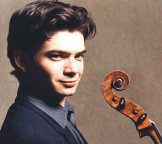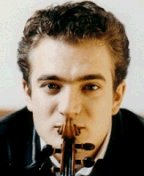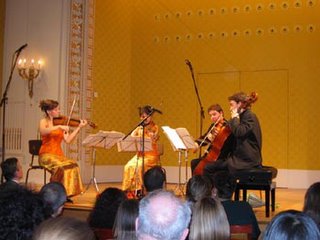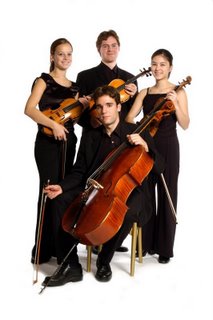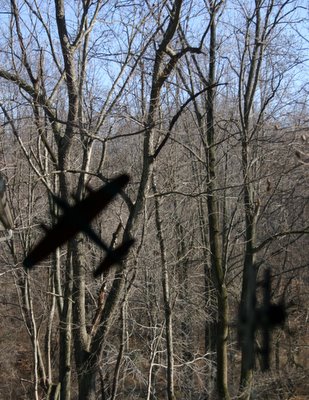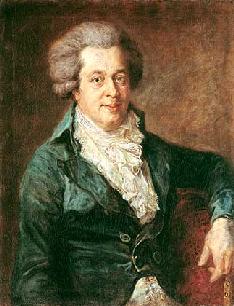Last month | Next monthClassical Month in Washington is a monthly feature that appears on the first of the month. If there are concerts you would like to see included on our schedule, send your suggestions by e-mail (ionarts at gmail dot com). Happy listening!Thursday, February 2, 7 pm
Bertrand Chamayou, piano
Music by Liszt, Debussy, Chabrier, Ravel
Cosponsored by the International Piano Festival of La Roque d'Anthéron
Rosslyn Spectrum Theater (1611 N. Kent St., Rosslyn, Va.)
Thursday, February 2, 8 pm
Chamber Music of
Roger Reynolds (winner of Pulitzer Prize, 1989)
Library of CongressThursday, February 2, 7 pm; Friday, February 3, 8 pm; Saturday, February 4, 8 pm
National Symphony Orchestra, with Choral Arts Society, in world premiere of Roberto Sierra's
Missa LatinaKennedy Center Concert Hall
Orchestra seats at
special discount price of $19.30 in honor of NSO's founding in 1930
See the
review by Jens F. Laurson (Ionarts, February 3)
Friday, February 3, 8 pm (Pre-concert lecture by Robin Rausch, 6:15 pm)
Cuarteto Casals (winner of the Yehudi Menuhin First Prize at the 2000 London International String Quartet Competition)
Music by Arriaga, Mozart, Zemlinsky
Library of CongressFriday, February 3, 8 pm
Alan Held, bass-baritone, and Kim Pensinger Witman, pianoWolf Trap
See the
review by Charles T. Downey (Ionarts, February 5)
Saturday, February 4, 1 pm
Metropolitan Opera National Council Middle Atlantic Regional AuditionsKennedy Center Terrace Theater
Saturday, February 4, 1:30 pm
Alfano,
Cyrano de BergeracSondra Radvanovsky and
Plácido Domingo Antonio Barasorda
Metropolitan Opera Radio Broadcast
Saturday, February 4, 8 pm
Baltimore Symphony Orchestra, with guest conductor Günther HerbigBruckner's ninth symphony and Mozart's third horn concerto
Music Center at Strathmore
See the
review by Jens F. Laurson (Ionarts, February 7)
Saturday, February 4, 8 pm
Ahn Trio (music by Kenji Bunch, Michael Nyman, Chick Corea, and David Bowie)
George Mason University Center for the Arts (Fairfax, Va.)
Saturday, February 4, 8 pm
Dawn Upshaw, Kronos Quartet, the Andalucian DogsMusic by Osvaldo Golijov, including
AyreLincoln Center, Rose Theater (New York, N.Y.)
See the
review by Allan Kozinn (
New York Times, February 6)
Sunday, February 5, 2 pm
Kennedy Center Chamber Players (Brahms trio, Poulenc sextet, and Beethoven septet)
Kennedy Center Terrace Theater
See the
review by Jens F. Laurson (Ionarts, February 9)
Sunday, February 5, 3 pm
The Brilliance of Bach: Chamber Music Majesty (The Musical Offering, the Concerto for Two Harpsichords in C Major and the Triple Concerto for Flute, Violin and Harpsichord)
Washington Bach ConsortRachel M. Schlesinger Concert Hall and Arts Center (Alexandria, Va.)
Sunday, February 5, 4:30 pm
Contemporary Music ForumMusic by Robert Gibson, Anthony Villa, Matthew Burtner, Mark Kuss, Stephen Paulus
Corcoran Gallery of Art
Sunday, February 5, 5 pm
Verdehr Trio (piano, clarinet, violin)
Phillips Collection [FREE, with price of admission to the museum]
See the
review by Cecelia Porter (
Washington Post, February 7)
Sunday, February 5, 6:30 pm
Mozart Piano Quartet (all-Mozart program in conjunction with
Mozart on the Mall concert series)
National Gallery of ArtSunday, February 5, 7:30 pm
Smithsonian Chamber OrchestraMusic by Shostakovich and Schubert
Renwick Gallery
See the
review by Joe Banno (
Washington Post, February 7)
Tuesday, February 7, 12:10 pm
Noontime Cantata:
Schau, lieber Gott, wie meine Feind (BWV 153)
Washington Bach Consort
Church of the Epiphany (13th and G Streets NW)
See the
review by Jens F. Laurson (Ionarts, February 8)
Tuesday, February 7, 7:30 pm
Music and Memory: A 70th Birthday Celebration of Nicholas Maw
Solo, chamber, and vocal works performed by students and alumni of the Peabody Conservatory of Music and members of the Baltimore Symphony Orchestra
An die Musik LIVE! (Baltimore, Md.)
See the
review by Tim Smith (
Baltimore Sun, February 9)
Tuesday, February 7, 8 pm
Alfred Brendel, pianoKennedy Center Concert Hall (WPAS)
See the
double review by Jens F. Laurson and Charles T. Downey (Ionarts, February 9)
Thursday, February 9, 7:30 pm
Dame Felicity LottKennedy Center Terrace Theater (VAS)
See the
review by Daniel Ginsberg (
Washington Post, February 11)
Thursday, February 9, 7 pm; Friday, February 10, 1:30 pm; Saturday, February 11, 8 pm
National Symphony Orchestra with conductor Christoph von Dohnányi and cellist Alban GerhardtKennedy Center Concert Hall
See the
review by Jens F. Laurson (Ionarts, February 10)
Thursday, February 9, 8 pm; Friday, February 10, 8 pm; Saturday, February 11, 8 pm; Sunday, February 12, 4 pm (with pre-concert lectures by composer and librettist, one hour before each performance)
Andrew Simpson,
The Furies [FREE]
Libretto by Sarah B. Ferrario, based on Aeschylus
Directed by Michael Scarola (New York City Opera)
Benjamin T. Rome School of Music, Ward Recital Hall
Catholic University of America
See the
review by Charles T. Downey (Ionarts, February 13)
Friday, February 10, 7:30 pm (Mt. Vernon Hand Chapel, George Washington University, Mt. Vernon Campus, 2100 Foxhall Rd. NW)
Sunday, February 12, 7:30 pm (Christ Lutheran Church, 8011 Old Georgetown Road, Bethesda, Md.)
Friday, February 17, 7:30 pm (Saint George's Episcopal Church, 915 N Oakland Street, Arlington)
Sunday, February 19, 7:30 pm (Christ Lutheran Church, 8011 Old Georgetown Road, Bethesda)
Sergei Rachmaninoff's
Aleko (one-act opera written for graduation from the Moscow Conservatory, based on a Alexandre Pushkin's poem
The Gypsies)
Opera Bel CantantiSee the
review by Joan Reinthaler (
Washington Post, February 13)
Friday, February 10, 8 pm
Baltimore Symphony Orchestra: A Night in HavanaCuban-inspired music by Gershwin, Copland, Piazolla
Music Center at Strathmore
See the
review by Tim Smith (
Baltimore Sun, February 11)
Friday, February 10, 8 pm; Saturday, February 11, 8 pm; Sunday, February 12, 8 pm
Flower of Passion, Thorn of Despair (chansons by Guillaume Dufay, Gilles Binchois, Robert Morton, Johannes Stahl, Jacques Vide, and others)
Asteria (early music duo, voice and lute)
Dumbarton Oaks (Friends of Music)
Friday, February 10, 8 pm
Mark Morris Dance GroupGeorge Mason University Center for the Arts (Fairfax, Va.)
See the
review by Sarah Kaufman (
Washington Post, February 13) and the
review by Jean Battey Lewis (
Washington Times, February 13)
Friday, February 10, 8 pm (Pre-concert lecture by Karen Moses, 6:15 pm)
Czech Nonet (Novák's Balleti à 9, Mozart's Oboe Quartet, K. 370, and Brahms Serenade in D Major, op. 11, in original version reconstructed by Alan Boustead)
Library of CongressSee the
review by Andrew Lindemann Malone (
Washington Post, February 13)
Friday, February 10, 8 pm
Brentano String QuartetMusic by Haydn, Ligeti, Beethoven
Corcoran Gallery of Art
See the
review by Jens F. Laurson (Ionarts, February 15)
Saturday, February 11, 1:30 pm
Verdi,
La TraviataAngela Gheorghiu
Metropolitan Opera Radio Broadcast
Saturday, February 11, 5 pm (with preconcert discussion at 4 pm)
21st-Century Consort, Time and Memory (modern music influenced by Mozart)
Hirshhorn Museum and Sculpture Garden
See the
review by Gail Wein (
Washington Post, February 13)
Saturday, February 11, 7:30 pm
Kalichstein-Laredo-Robinson Trio (Shostakovich and Mozart piano trios)
Kennedy Center Terrace Theater
See the
review by Jens F. Laurson (Ionarts, February 14)
Saturday, February 11, 8 pm
Sacred Kaleidoscope (sacred music from Sweden, Russia, Germany, Estonia, Israel, England, and New Zealand) [CANCELLED BECAUSE OF SNOW]
Woodley EnsembleSt. Peter's Catholic Church (312 Second Street SE)
Sunday, February 12, 3 pm
Opera Lafayette with tenor Jean-Paul Fouchécourt, Rameau airs
Clarice Smith Performing Arts Center (College Park, Md.)
See the
review by Charles T. Downey (Ionarts, February 13)
Sunday, February 12, 3 pm and 7:30 pm
Chatham Baroque (Julie Andrijeski, baroque violin, Patricia Halverson, viola da gamba, and Scott Pauley, theorbo and baroque guitar)
Music of Bach and other Baroque composers
The Mansion at Strathmore
Sunday, February 12, 5 pm
Dudana Mazmanishvili, piano (Georgian-born winner of 2005 Washington International Piano Competition)
Phillips Collection [FREE, with price of admission to the museum]
Sunday, February 12, 5 pm; Sunday, February 19, 5 pm
Washington Metropolitan PhilharmonicMusic by Hovhannes, John Williams, Grofe
Bishop Ireton High School (Alexandria, Va.) [2/12]
Church of the Epiphany (13th and G Streets NW) [2/19]
Sunday, February 12, 6 pm
The Conservatory Project: Curtis Institute of Music
Rob Patterson (clarinet), Michael Haas (cello), and Sara Daneshpour (piano) in a performance of works by Rachmaninoff, Stravinsky, Crumb, and Brahms
Millennium Stage Event [FREE]
Kennedy Center Terrace Theater
Sunday, February 12, 6:30 pm
Auryn String Quartet, with violinist Hartmut Rhode
Music by Haydn, Bartók, and Dvořák
National Gallery of ArtMonday, February 13, 8 pm
Royal Concertgebouw with Mariss JansonsKennedy Center Concert Hall (WPAS)
See the
review by Charles T. Downey (Ionarts, February 15)
Monday, February 13, 8 pm
Baltimore Symphony Orchestra, with incoming Music Director Marin Alsop (Brahms, Rouse, Dvořák)
Music Center at Strathmore
Same program
reviewed by Jens at Meyerhoff Hall last month
Monday, February 13, 8 pm
National Symphony Orchestra/JCC Chamber Music Series
Mozart’s A Musical Joke (The Village Musicians), Hindemith’s Octet, and Quintet in C minor for Piano and Strings by Vaughan Williams
Jewish Community Center of Greater Washington (Rockville, Md.)
Monday, February 13, 6 pm
The Conservatory Project: Manhattan School of Music
Escher String Quartet
Millennium Stage Event [FREE]
Kennedy Center Terrace Theater
Tuesday, February 14, 6 pm
The Conservatory Project: Indiana University Jacobs School of Music
Millennium Stage Event [FREE]
Kennedy Center Terrace Theater
Wednesday, February 15, 2006
The Conservatory Project: University of Michigan School of Music
Scenes from
The Coronation of PoppeaMillennium Stage Event [FREE]
Kennedy Center Terrace Theater
Thursday, February 16, 6 pm
The Conservatory Project: Cleveland Institute of Music
Millennium Stage Event [FREE]
Kennedy Center Terrace Theater
Friday, February 17, 6 pm
The Conservatory Project: New England Conservatory of Music
Millennium Stage Event [FREE]
Kennedy Center Terrace Theater
Friday, February 17, 8 pm
Peter Schickele -- Louis C. Elson Memorial Lecture
Library of Congress (rescheduled from December 7)
See the
comments by Charles T. Downey (Ionarts, February 18)
Friday, February 17, 8 pm; Sunday, February 19, 2 pm
Mozart,
The Marriage of FigaroVirginia Opera
George Mason University Center for the Arts (Fairfax, Va.)
See the
review by Mark J. Estren (
Washington Post, February 20)
Saturday, February 18, 1 pm and 3:30 pm
NSO Kinderkonzert: Musical OppositesKennedy Center Family Theater
Saturday, February 18, 1:30 pm
Verdi,
AidaAndrea Gruber, Olga Borodina, Johan Botha, Juan Pons
Conducted by James Conlon
Metropolitan Opera Radio Broadcast
Saturday, February 18, 6 pm
The Conservatory Project: Oberlin Conservatory of Music
Millennium Stage Event [FREE]
Kennedy Center Terrace Theater
Saturday, February 18, 7:30 pm
Countertop Quartet, Modern Voices (music by Michael Harrison, Richard Rice, Terrance Johns, Francis Poulenc, and Maurice Duruflé)
St. Paul’s Church, K Street (2430 K Street NW)
Saturday, February 18, 8 pm
Mozart, Mozart, MozartNational Philharmonic, with Brian Ganz and Jody Gatwood
The Music Center at Strathmore
See the
review by Joan Reinthaler (
Washington Post, February 20)
Sunday, February 19, 1 pm and 3:30 pm
NSO Ensemble Concert: Connections--Math and Music (ages 9 and up)
Kennedy Center Family Theater
Sunday, February 19, 3 pm; Thursday, February 23, 7:30 pm; Saturday, February 25, 7:30 pm
Puccini,
TurandotKirov Opera (Valery Gergiev)
Kennedy Center Opera House
See the
review by Jens F. Laurson (Ionarts, February 21)
Sunday, February 19, 5 pm
Ted Christopher, baritone
Phillips Collection [FREE, with price of admission to the museum]
Sunday, February 19, 6:30 pm
Kuijken String Quartet (Mozart's first three Haydn quartets)
National Gallery of ArtSunday, February 19, 7 pm
Beautiful Music: The Best of Rooms (music by Langlais, Biebl, Messiaen, Nestor, et al.) [FREE]
Catholic University of America Chorus and Chamber Choir
Leo C. Nestor, conductor
Basilica of the National Shrine of the Immaculate Conception, Crypt Church
Monday, February 20, 8 pm; Tuesday, February 21, 8 pm
Osvaldo Golijov,
La Pasión Según San Marcos ("The Passion According to St. Mark")
Schola Cantorum de Caracas, Orquesta La Pasión, and Atlanta Symphony Orchestra, conducted by Robert Spano
Lincoln Center, Rose Theater (New York, N.Y.)
See the
review by Anthony Tommasini (
New York Times, February 21), with a great picture of
Anne-Carolyn BirdTuesday, February 21, 6 pm; Sunday, February 26, 3 pm
Wagner,
ParsifalKirov Opera (Valery Gergiev)
Kennedy Center Opera House
See the
review by Jens F. Laurson (Ionarts, February 23)
Tuesday, February 21, 7:30 pm
Washington Musica Viva, Czech Music Series
Music by Martinů, Dvořák, Eben
Embassy of the Czech RepublicTuesday, February 21, 8 pm
Kuijken String Quartet (Mozart's last three Haydn quartets)
Library of CongressSee the
review by Stephen Brookes (
Washington Post, February 23)
Tuesday, February 21, 8 pm
Magdalena Kožená, with Les Violons du RoyRameau's Suite from
Dardanus, opera arias by Gluck and Mozart, Rebel's
Les ÉlémensTuesday Evening Concert Series, Old Cabell Hall
University of Virginia (Charlottesville, Va.)
See the
review of their concert in Los Angeles by Richard S. Ginell (
Los Angeles Times, February 16)
Wednesday, February 22, 7:30 pm
Rachel Barton Pine, violin [FREE]
Make a reservation by phone (202-783-7370) or e-mail (reservations at nmwa dot org)
National Museum of Women in the ArtsSee the
review by Charles T. Downey (Ionarts, February 24)
Thursday, February 23, 7 pm; Friday, February 24, 8 pm; Saturday, February 25, 8 pm
National Symphony Orchestra with violinist MidoriKennedy Center Concert Hall
See the
review by Jens F. Laurson (Ionarts, February 24)
Thursday, February 23, 7 pm; Friday, February 24, 7 pm
Humperdinck,
Hansel and Gretel (free, staged, in English)
Domingo-Cafritz Young Artists, Washington National Opera
IDB Cultural Center (1330 New York Avenue NW)
See the
review by Tim Page (
Washington Post, February 24)
Friday, February 24, 7:30 pm; Saturday, February 25, 7:30 pm
Renaissance Music for an English Cathedral: Weelkes and Tomkins
ChantrySt. Mary Mother of God
Friday, February 24, 8 pm
Joyce Yang, piano (2005 Silver Medalist, Van Cliburn International Competition)
The Barns at Wolf Trap
See the
review by Tom Huizenga (
Washington Post, February 27)
Friday, February 24, 8:30 pm
Verdi, RequiemKirov Opera and Orchestra, conducted by Valery Gergiev
Kennedy Center Opera House
See the
review by Jens F. Laurson (Ionarts, February 25)
Saturday, February 25, 1:30 pm
Saint-Saëns,
Samson et DalilaOlga Borodina and Plácido Domingo
Metropolitan Opera Radio Broadcast
Saturday, February 25, 7:30 pm
Left Bank Concert Society (music by George Walker, Curt Cacioppo, George Crumb, Beethoven String Quartet)
Kennedy Center Terrace Theater
See the
review by Jens F. Laurson (Ionarts, February 28)
Saturday, February 25, 8 pm
Rimsky-Korsakov's Scheherazade and Saint-Saën's Organ SymphonyNational Philharmonic, with organist William Neil
The Music Center at Strathmore
See the
review by Joe Banno (
Washington Post, February 27)
Saturday, February 25, 8 pm
Meredith Monk and Vocal Ensemble:
The Impermanence ProjectGeorge Mason University Center for the Arts (Fairfax, Va.)
See the
review by Charles T. Downey (Ionarts, February 26)
Sunday, February 26, 5 pm
Ensō String QuartetPhillips Collection [FREE, with price of admission to the museum]
Sunday, February 26, 5:30 pm
Vienna Piano Trio
The Helen Coplan Harrison Concert
Shriver Hall, Johns Hopkins (Baltimore, Md.)
See the
review by Charles T. Downey (Ionarts, February 27)
Sunday, February 26, 6:30 pm
Larry Eanet
(guitarist) (pianist--sorry, Larry!) and Ensemble
Post-World War I jazz presented in honor of Dada
National Gallery of ArtSunday, February 26, 7 pm
Academy of St. Martin in the FieldsGil Shaham, guest director/violin
The Music Center at Strathmore (WPAS)
See the
review by Jens F. Laurson (Ionarts, February 28)
Monday, February 27, 8 pm
Jerusalem Symphony with Leon Botstein, conductorMartinů,
Památník Lidicím (Memorial to Lidice); Copland,
Appalachian Spring; Prokofiev, Symphony No. 5 in B-flat major, Op. 100
Music Center at Strathmore
See the
review by Charles T. Downey (Ionarts, March 1)
